|
BIOGRAPHIES INDEX

Van Zandt Family
Christoffel Harmenszen |
Gerrit Stoffeles Vansand |
Jacobus Vansand
Isaiah Vansand, Sr. |
Isaiah Vanzant, Jr. |
John Vanzandt |
Sarah Vanzandt Coons
Some Noteworthy Van Zandt Cousins
THE VAN ZANDT FAMILY
(Also spelled VANZANDT/VAN SANDT/VANSANT/VANSANDT/VINZANT/VINSANT)
By Steven R. Butler, Ph.D.
PLEASE NOTE: This is a work in progress. First posted January 14, 2025.
My Connection
I am a Van Zandt family descendant by virtue of the marriage of my maternal great-great-grandfather, Thomas William Jenkins, to Louisa I. Williams, who was the daughter of John I. Williams and Delilah Coons, who was the daughter of Martin Coons, Jr. and Sarah Van Zandt, who was the daughter of John Van Zandt of Tennessee, U.S.A. Here is a link to my entire Van Zandt family tree.
A Long and Interesting Story
The history of our Van Zandt ancestors and relations in America is a long and interesting story, spanning nearly four centuries - from the early seventeenth century to the present-day. Originating in both the Netherlands and what is now Germany, our earliest ancestors arrived in North America in 1652 (or thereabouts). They initially lived in New Amsterdam (now New York City), the capital of what was then known as Nieuw Nederlandt (New Netherland). From there, they moved across the harbor to New Utrecht on Long Island, a community now engulfed by the New York borough of Brooklyn. About 1699, the family migrated to Bucks County, Pennsylvania, where three generations lived before moving on again, this time to Virginia and then Tennessee, before some members of the family went on to Texas, where their descendants still live to this day.
Luckily for me, by the time I started to investigate my Van Zandt ancestors and relations, I discovered that some earlier Van Zandt descendants had already done extensive research on this family, "blazing the trail," so to speak, leaving me and all our various cousins to reap the reward of their work. For this, I am very grateful. In all too many cases, regarding the other families from whom I'm descended, I have been the trail-blazer. Not so with the Van Zandt family.
The only complaint I have is that while some researchers have been meticulous in documenting their sources, which I very much appreciate, others have not been as careful, making it difficult, in some cases, to track down the evidence that supports their statements. For that reason, I have tried to be as scrupulous as I can to provide the source of the information contained within this account, so that others can find and see it for themselves.
Christoffel Harmenszen
(1618-1655)
Although it was previously believed that our earliest Van Zandt ancestor in America was "Gerret Stoffelse Van Sandt or Van Zandt, (otherwise Garret Van Sandt, son of Stoffel or Christopher), who emigrated from the Netherlands, probably from Zaandani in North Holland, or Zandberg in Drenthe, in or about the year 1651, and settled in New Utrecht, Long Island," we now know (thanks to further research) that Gerret's father - Christoffel (or just Stoffel) Harmenszen - and his stepmother - Trijntje Claes - were likewise immigrants from the Netherlands. Furthermore, we also now know that before settling on Long Island, they lived in old Amsterdam, in Europe, and then in New Amsterdam (now New York City), the capital of New Netherland, during what is generally known as the Netherlands' "Golden Age."
According to all accounts, our ancestor Christoffel (or simply, Stoffel) Harmenszen, did not use the surname Van Zandt or any variation of that surname, such as Vansand or Vanzand ("van" means from and "sand" or "zand" means a sandy place), simply because that was not the custom before the middle of the seventeenth century. We also know that Christoffel Harmenszen was not actually Dutch, but German, being born about 1618 in the town of Jever, which is the capital of the district of Friesländer Landkreis, in what is now the German state of Lower Saxony (or Niedersachen in German or Deutsch) - a state that adjoins The Netherlands to the north and east. Jever, a small municipality even to this day, lies about 105 kilometers (about 65 miles) northwest of Bremen, one of the present-day larger cities of Lower Saxony. At the time that Christoffel Harmenszen was born there in 1618, Jever was part of the Duchy of Oldenburg. The present-day political entity of Germany or Deutschland did not then exist.
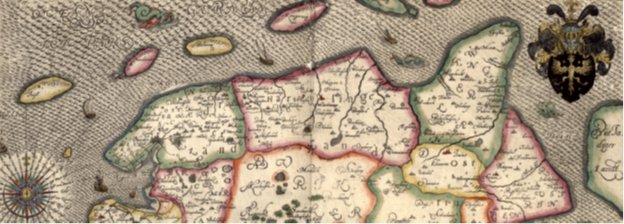
This portion of a vintage map, from an atlas entitled La Germanie inférieure de Petrus Keerius : c'est à dire nouvelles et exactes cartes géographiques des XVII provinces dicelle, published in Amsterdam in 1622, shows the location of the town of Jever, just above the word "Ost" (East in English). Courtesy Library of Congress, Washington, D.C.
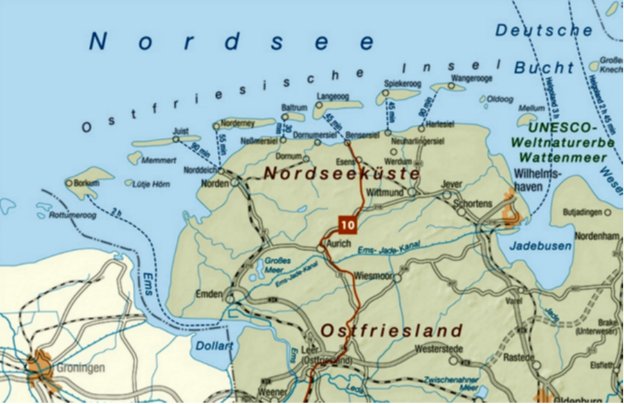
Here is a modern-day map showing the location of Jever (just to right and below the word "Nordseeküste," which translates to "North Sea Coast" in English. From ontheworldmap.com.
The pale-yellow portion of the above map shows Dutch territory (Green is Germany) and the location of the Dutch city of Groningen.
Sometime before he reached adulthood, Christoffel Harmenszen went to live in Amsterdam, the largest city in the Netherlands. There, he met and fell in love with a young woman named Moederke Gerrits.
Here is a harbor view of Amsterdam, Netherlands, where Christoffel Harmenszen went to live.

The picture below is from another map in La Germanie inférieure de Petrus Keerius : c'est à dire nouvelles et exactes cartes géographiques des XVII provinces dicelle, showing a typical Dutch couple. Perhaps this is what Christoffel and Moederke looked like?
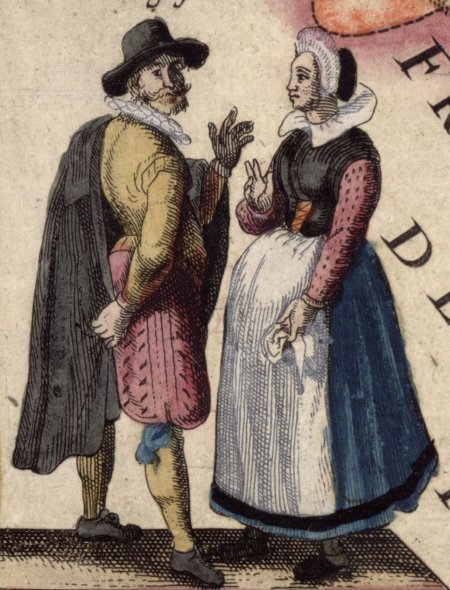
Our source for the birthplace of Christoffel Harmenszen (and also his occupation) is the written record of his intention to marry Moederke Gerrits of Amsterdam, dated June 13, 1643, which has been preserved in the City Archives of Amsterdam, reportedly the largest municipal archives in the world. Translated into English from Dutch, it reads as follows:
Christoffel Harmenss, from Jever, journeyman clothdresser (droogscheerdersgesel) living on the Hoochstraet, having no parents [living], age 25, and Moederke Gerrits, from Amsterdam, living on the Breestraet, attended by her mother Vroutie Pieters.
Here is a digital copy of the actual record of intention to marry for Christoffel Harmenszen and Moederke Gerrits.
From the Amsterdam, Netherlands Municipal Archives.
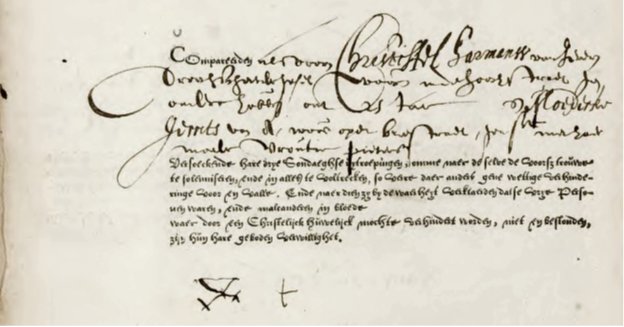
After Christoffel and Moederke were married in the Oude Kerk (Old Church) on June 28, 1643, they wasted no time in starting a family. Unfortunately, their marriage turned out to be a brief one when Moederke, died soon after giving birth to their first and only son, Gerrit, very likely due to complications following childbirth. A record of her burial, dated July 17, 1644, also preserved in the City Archives indicates that she was laid to rest in Amsterdam's St. Anthonis Cemetery.

Above: Burial record of Moederke Gerrits (or Gers)
The following year, on September 9, Christoffel Harmenszen declared his intention to marry a second time, this time to Trijnje Claes. The marriage took place in Amsterdam at the Oud Kerk (Old Church) - the same place that Christoffel had married his first wife -- this time on September 24, 1645.
Thanks to the efforts an earlier Van Zandt researcher named Rebecca Johnson, I have been fortunate to locate in the Archives of the City of Amsterdam, a "testament" dated July 10, 1649, in which Christoffel Harmenszen presumably made arrangements for what his wife and son would inherit in the event of his death. It can be found in Notary File No. 1092, dated 1649 Mei 1 (May 1, 1649) to 1650 Juni 5 (June 5, 1650), pages 31-33. The notary's name is Joost van de Ven. Unfortunately, the 3-page document is in Dutch, which I'm unable to read, though I can make out the names of all the parties involved. It is interesting to note that both Christoffel Harmenszen and wife were obviously illiterate, since they both signed the document with an "X." Only the notary, van de Ven, signed his name.
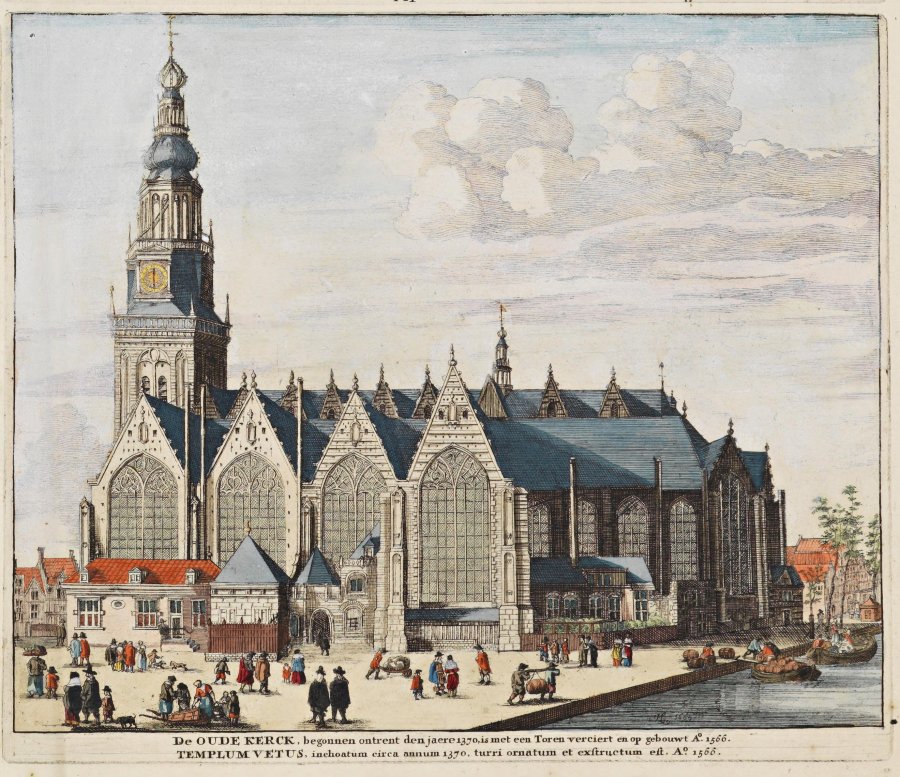
The Oud Kerk in Amsterdam, where Christoffel Harmenszen married both his wives.
As it happened, our Van Zandt ancestors lived in Amsterdam during an era now known as the Netherlands' "Golden Age," a time when artists like Rembrandt and Vermeer were producing some of their best work, and the Netherlands rivaled England as a colonial power, with which it went to war on more than one occasion. Rembrandt, for example, painted his enormous masterwork, "The Night Watch," in 1642 and in 1665, Vermeer painted his equally famous "The Girl with the Pearl Earring" (the subject of a modern-day motion picture, Girl with a Pearl Earring, starring Scarlett Johannsen). This was also the time when Nieuw Amsterdam (the future New York City) and Nieuw Nederlandt (New Netherland; present day New York and New Jersey) in America was thriving under the leadership of the stern but respected Governor-General Pieter Stuyvesant.
Two other interesting movies set during the Netherlands' "Golden Age" are Tulip Fever and The Admiral.
It was at this time that Christoffel and Trijnje, his second wife, decided to leave the "Old World," and try their hand as making a life in the "New World."
In the mid-1990s (or thereabouts), a researcher named Elva Kathleen Lyon discovered the below transcribed record in the "Noord Amerika Chronologie," -- a 5,000-card index to the notarial records of the city of Amsterdam from 1598-1750, which provides important information about persons who lived in New Netherland (present-day New York and New Jersey, including their European place of origin -- and translated it from Dutch into English. In 1996, it was called to the attention of other researchers by Barbara A. Barth of Massachusetts, who included it in a very thorough and informative family history account entitled "The Van Sant Family of New Utrecht and Bucks County, Pennsylvania, which was published in The New York Genealogical and Biographical Record, Vol. 127, No. 3, July 1996.
1652 April 16. Abraham de Wijs, merchant in Amsterdam, in the name of Cornelis de Potter, his brother-in-law, who lives in the Manhattans in New Netherland. He takes into service for him: Christoffel Harmens and Trijntje Claes, to work there for de Potter. Also their son Gerrit Christoffels, 8 years old, shall work with them. This is for a time period of three years, at 200 carolus guilders per year. Free board and room.
This notation also provides us with an approximate birth date (1644) for Christoffel Harmenszen's son, Gerrit or Gerret, who is also our ancestor. It also gives us the year they immigrated: 1652.
Since it might be interesting to know what kind of man our ancestors worked for, the following is a brief biography of Potter, taken from A. Doren Honeyman, Joannes Nevius and His Descendants (Plainfield, New Jersey: Honeyman & Company, 1900), pp.79-81:
CORNELIS DE POTTER…was…a man of more than average wealth and he was a most extensive trader. Of his parentage or residence in the Netherlands we know nothing; we do not know that he was born in the Netherlands. In a list of the students at the University of Groeningen, 1658, there is a "Jacques de Pottere" of Emden. Emden is a town on the east bank of the river Ems, once included in Holland, but now in Germany. It shows the name was not foreign to the Netherlands but that is all. Conjecturally, Cornelis de Potter was a native of the Netherlands.
He seems to have arrived with his family in this country in the summer of 1651. At all events, our first notice of him is on June 13, when he is noted in New Amsterdam as a joint owner with Gulean Wys of the "Spotted Cow," the vessel which brought over so many of the early emigrants. (Coll. Hist. MSS., Part I, Vol. 3, p. 53).
On August 29 he purchased land and cattle at "The Ferry" on Long Island (Brooklyn) and, on September 23, he joined with Governor Stuyvesant and others in a purchase at Harlem.
On December 24 "Lysbeth de Potter," his daughter, is a witness to a baptism in New Amsterdam.
The next year he is spoken of in the records of that place (O'Callaghan's "Register of New Neth.," p. 122), as one of the "advocates," which means, perhaps, that he could perform the duties of a lawyer, though there is no other evidence that such had ever been his chosen profession.
In January, 1652, he purchased two houses with lands at the Ferry, and his payments on his various land transactions in 1651 and 1652 can be figured at 6,475 guilders, ($2,590), equal to-day in money value at about $12,950. He was probably, therefore, a well-to-do man, though not a really wealthy one.
So, it appears that De Potter was not only a resident of New Amsterdam in 1651, but probably within two months of his arrival became a large land owner.
The next year, 1653, his daughter Elizabeth married Isaac Bedloo, six months before his step-daughter, Adriaentje, married Joannes Nevius.
Soon after this date, besides sundry other suits, he became involved in the long and tedious litigation with Vander Veen described in the next chapters, and thenceforth there is little recorded of him except concerning that affair until his death in 1660. In the meantime, it is noted, however, that he was long absent, whether to Holland, or, more probably, to the East Indies, cannot be determined. (See "Records of N. A.," as hereafter quoted).
Probably a David de Potter mentioned as a witness at baptisms in 1652 and 1653 and also as a magistrate at Flatlands in 1654 was a brother of Cornelis.
It is conjectured that another David de Potter, "catechumen" (student of the catechism) at the Brooklyn church, November 26, 1662, was not a son of the first named David, but of Cornelis. If so, he died before the execution of his mother's will in March, 1676. The fact that de Potter resided, as I suppose, in Brooklyn, or in Flatlands, absolved him from those various assessments and even free-will offerings which constantly fell on the burghers and thus his name does not often occur in the New Amsterdam records, aside from his land speculations and his litigations. The minutes from 1653 to 1660, when he died, only refer to him, except in connection with the lawsuit, a few times.
He was a slave owner, for we know that two of his slaves, Franciscus and Catharina, were married in 1659. I have sometimes wondered if his vessels as they came from the East Indies and, possibly, touched on the African coast, ever loaded up with some of the blacks then so easily to be procured and for which there was in New Amsterdam so ready a market. It is probably a libel upon his character to even suggest such a matter, but it must be remembered that human slavery was not considered reprehensible. Many a Nevius, beginning with Joannes, has owned one since.
As to the time of his death, we only know that he was living October 4, 1659, and that in October, 1660, "Swaentie Jans, widow of Corn. De Potter" joined the New Amsterdam Dutch church. It may be that he died while absent on one of his long journeys. * This is believed to be the case because all the evidence is that he was absent from America from about the middle of November, 1654, for at least a year or two and I have been unable to find any record of his presence in New Amsterdam subsequently up to the time of his death.
It might be added here concerning the property he left, that we have no special record of his personal estate, all of which, however, his widow seems to have received; and of his real estate, of which he had considerable prior to his death, the only record we have consists in various transfers of one-ninth shares of twenty acres each of the one hundred and eighty acres of his Brooklyn farm, made by his grandchildren.
*An Appendix to this book gives all dates in regard to de Potter in chronological order. The New Amsterdam records concerning him in connection with Joannes Nevius will be found in Chapter VII.
Some researchers have said that Christoffel Harmenszen's and his wife and son made the journey to America in 1650 or 1651, but that is clearly not the case in light of the fact that the indenture to which they agreed is dated 1652.
Owing to the fact that their employer was a half-owner of a ship called "The Spotted Cow" (or "De Gevlekte Koe" in Dutch), we may assume he provided their passage to America aboard that vessel. Owing to the additional fact that their employer resided in Brooklyn, we may also assume that Brooklyn (or thereabouts) is where the whole family lived and worked for the next three years, probably as cloth workers (Christoffel's trade). In addition to the fact that Christoffel and his family came to the New World as contract workers, we know that in 1655, only four years following our ancestors' arrival in America, a conflict called the "Peach War" broke out between the Dutch in New Netherland and the indigenous people, when a hot-tempered Dutch farmer by the name of Hendrick Van Dyck killed an Indian woman who he caught in the act of taking peaches from his orchard. Here is how the war was described in Ira K. Morris' Memorial History of Staten Island:

New Amsterdam, in America, from an old map, as viewed from Brooklyn, across the East River
…during the year 1655, another serious calamity befell the place. There had been considerable accessions to the population in the meantime, and there were strong assurances of peace. In the early autumn of this year, however, Hendrick Van Dyck, the former attorney general at New Amsterdam, a resident of Oude Dorp, on rising one morning, discovered a squaw in his garden stealing peaches, and in a moment of anger he shot her, killing her instantly. The authorities took little notice of this rash act; but the Indians did not overlook it. Immediate measures were taken by them to avenge the outrage, and then began the bloody siege known in history as the famous "Peach war." Several of the neighboring tribes united, and early on the morning of the 15th of September, sixty-four canoes, containing nineteen hundred savages, some of whom were Mohicans, and others from Esopus, Hackingsack, Tappan and Stamford, suddenly appeared before New Amsterdam. They landed and dispersed through the various streets, while many of the people were still asleep. Then they broke into several houses on pretense of looking for " Indians from the North," but in reality, to avenge the death of the squaw that Van Dyck had shot at Oude Dorp.
Immediately upon their discovery an alarm was given. The officers of the colony and city, and many of the principal inhabitants, assembled, and the leaders of the Indians were requested to meet with them, which they did. They accounted for their sudden appearance under the pretext of searching for some hostile northern Indians, who, they pretended they had been informed, were either in the city or its vicinity. After much persuasion they were induced to promise to go away from Manhattan Island at sunset; but when evening came they still manifested no disposition to leave. They became so unruly as to excite the people, and violent acts were committed by both parties. Paulus Leinderstein Van Der Grist, one of the city officials, was killed by a blow with an axe. The soldiers in the fort and the city guard were called out , and the invaders were driven back to their canoes. The savages then crossed the river and attacked the settlements there, killing or capturing most of the people. They then came to Staten Island, which at that time had a population of ninety souls, and eleven flourishing bouweries, all of which are supposed to have been at or near Oude Dorp. Twenty-two were killed, including Van Dyck, the thoughtless author of the trouble, and all the remainder who did not escape were carried away captive, and desolation reigned everywhere on the Island. Thus, for the third time, Oude Dorp was laid in ashes, never to be re-built. The Indians continued their ravages for three days, during which time they killed one hundred whites, took one hundred and fifty prisoners, and ruined three hundred more in their estates. Alarm spread throughout the entire region, and there was no safety anywhere, for the hostile Indians were prowling about day and night, and killed all who came within their reach.
Unfortunately, as previously noted, one of the Dutch settlers who were killed during the Peach War was none other than our ancestor, Christoffel Harmenszen. How, in spite of the fact that the Dutch had a fort in New Amsterdam, garrisoned by soldiers, the Indians were able to exact their revenge is due to the fact that when they attacked, Director-General Stuyvesant and six-hundred Dutch soldiers who ordinarily protected the town were away, themselves attacking a Swedish settlement in present-day Delaware, thus leaving New Amsterdam vulnerable and undefended. Although they defeated the Swedish, thus ending any further attempts by the Swedes to colonize North America, it obviously came at a high price.
According to at least one researcher, Christoffel Harmenszen was laid to rest in the New Utrecht Cemetery, Bensonhurst, Kings County (Brooklyn), New York, but I think it is more likely that he was buried in the Old Dutch Graveyard in New Amsterdam, a burying ground that has unfortunately disappeared from view.
Here is what the New York City Cemetery Project has to say about it:
"The earliest known cemetery of colonial Manhattan was located on the west side of Broadway, around present-day Morris Street. It is unclear when it was first established as a burial ground, but by 1656 it apparently had been in use for many years as it was referred to in Dutch records at that time as "The Old Graveyard, which is wholly in ruins." The Castello Plan of New Amsterdam in 1660…shows the cemetery's location along the west side of the main highway that later became known as Broadway. The dilapidated condition of the Old Graveyard was cause for concern again in 1665, when city officials described it as "open and unfenced, so that hogs root in the same." In 1676, the city ordered that the cemetery be broken into lots and sold at auction."
"What happened to the burials in the Old Graveyard after it was disposed of by the city is unknown. It is possible that the graves were moved to the new burial place that had been established further north along Broadway at what is now the northern end of Trinity churchyard. A more likely scenario (and one that is seen repeatedly for the city's later public cemeteries) is that the graves were left in place and the area filled in before the land was reused. Evidence of the Old Graveyard was discovered in the mid-1800s when workmen uncovered human remains while excavating cellars in the area. Today, the high-rise office buildings that cover the site have obliterated all signs of this early colonial graveyard."
According to the New York City Cemetery Project, which has done extensive research on this topic, comparing old maps to newer ones, the old Dutch Cemetery was located inside the block now bounded by Broadway on the east, Morris Street on the south, Trinity Place on the west, and Exchange Place on the north, though closer to the Morris Street end of that area, somewhere between 29 and 39 Broadway.
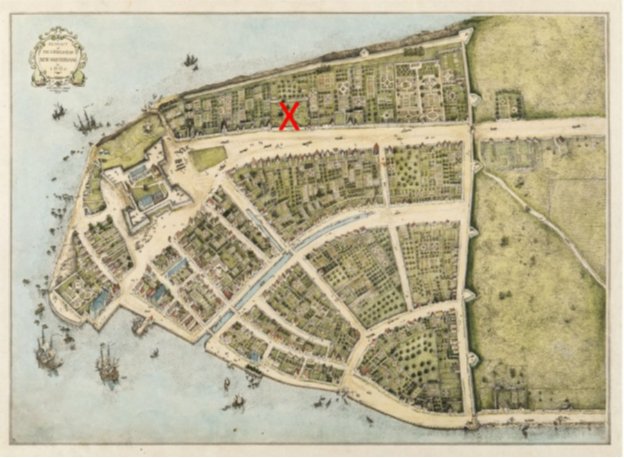
The Castello Map or Plan of New Amsterdam (North is to the right), showing location of old graveyard
Gerret Stoffelse Vansand
(1644-1706)
Here is a brief account of the life of our ancestor, Gerret Stoffelse Van Zandt, taken from: William W. H. Davis, History of Bucks County, Pennsylvania (New York & Chicago: The Lewis Publishing Company, 1905), p.24.
"The Vansants of Bucks county are descendants of a common ancestor, Gerret Stoffelse Van Sandt or Van Zandt,* (otherwise Garret Van Sandt, son of Stoffel or Christopher), who emigrated from the Netherlands, probably from Zaandani in North Holland, or Zandberg in Drenthe, in or about the year 1651, and settled in New Utrecht, Long Island, on the records of which town he is frequently mentioned as Gerret Stoffellse. He was one of the fourteen patentees mentioned in the patent from Governor Thomas Dongan, May 13, 1686, for the Commons of New Utrecht, "on behalf of themselves and their associates, the present freeholders and inhabitants of the said towne." His land was located at Yellow Hook, 'under the jurisdiction of the town of New Utrecht.' He was a magistrate of New Utrecht in 1681."
"By deed dated July 31, 1695, he conveyed his Yellow Hook plantation to Derick Janse Van Zutphen, and removed to Bucks county, where Joseph Growdon on 12 mo. 10, 1698-9, conveys to him 150 acres in Bensalem township, and on the same date conveys a like tract adjoining to his son Cornelius. It is probable that he was located for a time in New York, as he had two children baptized at the Dutch Reformed church there in 1674 and 1676, respectively. It is generally conceded that he was twice married, as the record of the baptisms above mentioned gives the name of his wife as Lysbeth Gerritz, while the later baptisms at New Utrecht and Flatbush churches give it as Lysbeth Cornelis. It is, however, possible that in one instance her father's surname is used and in the other his first name as was common on the Dutch records. Cornelius Gerrets was a member of the Dutch church at New Utrecht. Garret Vansand died intestate in Bensalem township, Bucks county, Pennsylvania, prior to June 5, 1706, the date upon which his ten children make a conveyance of his land purchased as before stated in February, 1698-9. The record of baptism of seven of his ten children appears at the Dutch church of New Netherlands, and will be given in connection with a sketch of each child, taken in regular order of birth, later in this article. The names of the ten children were: I. Stoffell; 2. Cornelius; 3. Josias; 4. Harman; 5. Albert; 6. Johannes; 7. Jacobus; 8. George; 9. Jesina, and 10. Garret. (Harman was really the third child in order of birth, and Josias fourth)."
A correction to the above account: In 1652 (not 1651), eight-year-old Gerrit Stoffelse immigrated to New Netherland with his father, Christoffel Harmenszen, and stepmother, Trijntje Claes, from Amsterdam, initially settling in New Amsterdam. It appears that he did not go to live in New Utrecht until after his father died in 1655 and his stepmother remarried in 1657, when he was about 14-years-old.
An extract from the translated Minutes of the Orphanmasters of New Amsterdam, 1655 to 1663, dated May 11, 1657, tells the story of how Christoffel's wife and son coped with his loss afterward.
Whereas Tryntie Clasen, widow of Stoffel Harmensen, cloth worker,[6] perished in the attack of the Indians in 1655, now intends to marry Rut Joosten van Brunt, bachellor, whereas said Stoffel Harmensen has left with Tryntie Clasen a minor son, by his first wife about 12 years old, and whereas the testament of said Stoffel, made before Notary Judicq van der Vin and witnesses at Amsterdam July 10, 1649, and shown to the Orphanmasters of this City, shows that said boy should have one half of his deceased father's estate, Therefore it is deemed necessary, that impartial parties should either by inventory or appraisement of the estate, left by said Stoffel Harmensen, look into and settle the child's share. For this purpose the Orphanmasters have requested and commissioned, as they hereby do, Sieur Johannes Nevius and Jacques Corteljou conscientiously to settle as guardians with said Tryntie Clasen what is coming to said child from the estate of his father, etc. etc. etc. Done etc.
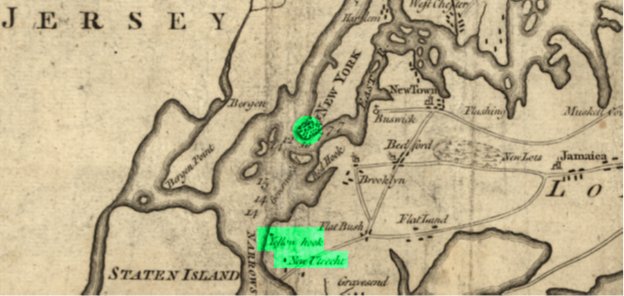
Map showing location of New York City (formerly New Amsterdam), Yellow Hook, and New Utrecht
As other Van Zandt family researchers have previously pointed out, the two men appointed as guardians of our the 12-year-old ancestor, Gerrit Stoffelse, were quite important figures in New Amsterdam. Johannes Nevius was "Secretary on the Part of the Burgomasters and Schepens of the city of Amsterdam in New Netherland," and Jaques Cortelyou, a French Huguenot, was a real estate speculator and the Surveyor General of the colony, and also founder of New Utrecht on Long Island (located in what is now the Borough of Brooklyn). Cortelyou is particularly famed for drawing the first detailed map of New Amsterdam, seen below, popularly called the "Castello Plan," because it was rediscovered the in the Villa di Castello, near Florence, Italy, in 1900, bound inside an atlas belonging to a member of the famed Medici family. Van Zandt researcher Barbara Barth has speculated that as a result of having two such well-educated and well-connected men as guardians, our ancestor probably received a good education. Cortelyou's guardianship may also account for why our ancestor ended up living at New Utrecht. The fact that his stepmother's second husband had a farm near there (at Yellow Hook, according to all accounts), may also account for his later residence on Long Island.
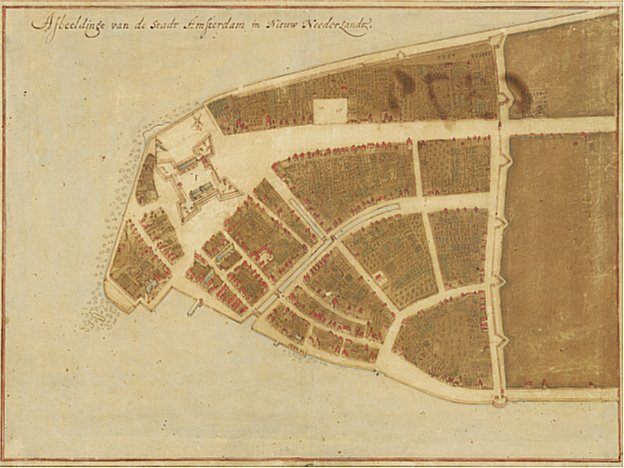
Original map of New Amsterdam, by Jacques Cortelyou
I have attempted to find copies of the original records referenced in History of Bucks County, Pennsylvania, including Governor Thomas Dongan's patent, in which our ancestor is named as one of the twenty-five (not fourteen) patentees of the town of New Utrecht (along with his guardian, Jacques Cortelyou, and his stepmother's second husband, Rut Joosten). In the process, I've found not only a copy of the original patent, but also both a handwritten and printed transcript which reads as follows (note: the names are in the middle of the second paragraph).
Thomas Dongan, Lieut. Governor and Vice Admirall of New-Yorke and its dependencies under his Majesty James the II, by the Grace of God of England, Scotland, France and Ireland, King, Defender of the faith, &c . Supreame Lord and proprietor of the Colony and Province of New-Yorke and Dependencies in America, &c. To all whome this shall come, sendeth greeting.
Whereas there is a certain Towne in King's County on Long- Island, commonly called and knowne by the name of New-Utrecht, Beginning at the North-East corner of the land appurtaining to Mr. Paulus Vanderbeeck called Goanus to the Bounds of Flattbush Pattent, and soe along the said bounds of the said Pattent, and stretching from thence South-East and by South till they meete the Limitts of Flattlands, Gravesend, and the said Utrecht, and from thence along Gravesend Bounds to the Bay of the North River, and soe along the said Bay and River till it meets the Land of the said Paulus Vanderbeeke as according to severall agreements and writeings and the pattent from Governor Richard Nicoll, dated in the year 1666. And whereas applicacon hath to mee been made by persons deputed from the aforesaid Towne of New-Utrecht for a confirmation of the aforesaid Tract of Land and premises; now Knowe Yee, that not only virtually by Virtue of, &c. I have Given, Granted, Ratified and Confirmed, and by these presents doe Give, Grant, Ratify and Confirme unto Jacques Corteljour, Ruth Joosten, John Verkerke, Hendrick Mathyse, John Kiersen, John Vandyck, Guisbert Thyson, Carel Van Dyck, Jan Van Cleef, Cryn Jansen, Meyndert Coerten, John Hansen, Barent Joosten, Teunis Van Pelt, Hendrick Van Pelt, Lawrence Janse, Gerrit Cornelissen, Dirk Van Stutphen, Thomas Tierkson, Gerrit Stoffelsen, Peter Thysen, Anthony Van Pelt, Anthony Duchaine, Jan Vandeventer, and Cornelis Wynhart, on Behalf of themselves and their associates, the present Freeholders and Inhabitants of the said Towne of New Utrecht, their Heirs , Successors and Assigns; All and singular, &c . To have and to hold the said Tract and parcell of Land with their and every of their appurtenances to them the said Jackues Corteljour, &c .-To bee holden of his said Majesty, his Heires and Successors in free and common Soccage, according to the Tenure of East Greenwich in the County of Kent in his Majestyes Kingdome of England ; Yielding, Rendering, and paying therefor, Yearly and every year, on every five and twentyeth Day of March, forever, six bushels of good Winter merchantable Wheate att tree Citty of New-Yorke, &c . Given under my hand, and sealed with the seale of the Province att Fortt James, in New-Yorke, the 13th day of May, 1686, and in the 2nd yeare of his Majestyes Reigne.
In September 1687, while living at New Utrecht, Gerrit Stoffelse took an Oath of Allegiance to His Majesty, King James II of Great Britain, along with all or most of the other residents of the town. (See E. B. O'Callaghan, The Documentary History of New York, Vol. 1 (Albany: Weed, Parsons & Co., 1850), p.531.
According to some other researchers, as a young adult Gerrit Stoffelse was a tenant on his stepmother's second husband's farm at Yellow Hook (so-called on account of the color of the clay in the area), located on or near the water of New York Harbor, only a few miles northwest of New Utrecht. Later, he had an 18-acre farm of his own at Yellow Hook (the name was changed to Bay Ridge in 1853, after a Yellow Fever epidemic made the color yellow unpopular). On February 1, 1691 (O.S.), he acquired two additional half-lots from a man named Dionys or Denyse.
Four years later, on July 31, 1695, he sold these half-lots to Dirck van Zutphen, the transaction for which was recorded in Liber A of the New Utrecht town records as follows:
Deed for land at Yellow Hook, Kings County, New York
from Gerrit Stoffelse to Dirck Van Zutphen
(Translated from the Dutch, New Utrecht Town Records Liber A, p.145)
On this the 31st of July 1695, appeared before me, Joost de Baene, licensed clerk of the town of New U?trecht in Kings County on the island Nassau in America, present the hereunder subscribed witnesses, the worthy Gerrit Stoffelsen, resideing at the Yellow Hoek under the jurisdiction of New U?trecht, who acknowledged for himself and his heirs to transport and tot convey, just as he transports and conveys by these presents in full free possession to Dirck van Zutphen and his heirs, also residing at the Yellow Hoek under the jurisdiction of New U?trecht, certain two half lots of land, also situated at the Yellow Hoek under the jurisdiction of New U?trecht, between the lane which lies between the land of the widow of Zwaen Jansen and (between) the land of Dirck van Zutphen: the above described land long and wide according to the measurements thereof, which are remaining under Pieter Carteljou; with all that which depends thereon: promise him, Dirck van Zutphen, for myself and my heirs to free him and his heirs from all subsequent claims, except the Lord's right, inasmuch as I am satisfied therfor in full. Thus done without deceit or guile, under bond as according to laws, and in token of the truth I have subscribed this with my own hand, in presence of the hereunder subscribed witnesses. Actum in New U?trecht on date as above.
Gerrit Stoffelsen
Witnesses -
Peter Corteljou,
Justice
Cornelis van Brunt
Joost de Baene,
Clerk
Interestingly, the amount of money that changed hands in this transaction is not stated, nor does there seem to be a deed on file, recording the sale of his 18-acre farm, which he must have sold prior to moving to Bucks County, Pennsylvania in or about 1699.
In or about 1668, when Gerrit was 24-years-old, he married Lysbeth Cornelis Gerrits, place unknown (but probably either New Amsterdam or New Utrecht). Together, they had the following named ten children:
- Stoffell (named for Gerrit's father, obviously), born 1670
- Cornelius (possibly named for his mother's father), born 1672
- Harman, born 1674 (see New Amsterdam Dutch Reformed Church Baptismal Record, p.115)
- Josias, born 1676 (see New Amsterdam Dutch Reformed Church Baptismal Record, p.125)
- Albert, born 1681
- Johannes or John, born 1683
- Jacobus (my ancestor), born 1685
- George, born 1687
- Syntje or Jesina, born 1689 (See Brooklyn and Flatbush Dutch Reformed Church Baptismal Record, p.121)
- Garret, born 1690
As previously noted, in 1699, Gerrit Stoffelse and his family moved from Long Island to Bucks County, Pennsylvania, where, for 28 Pounds and 15 Shillings "current silver money of the province," he purchased 150 acres of land in or near Bensalem, alongside the Neshaminy River, along with "all messuages and tenements, barns, stables, ways, water privileges, improvements and all other appurtenances and advantages," from a man named Joseph Growden. This deed is also the first known example of our ancestor using the surname Vansand.
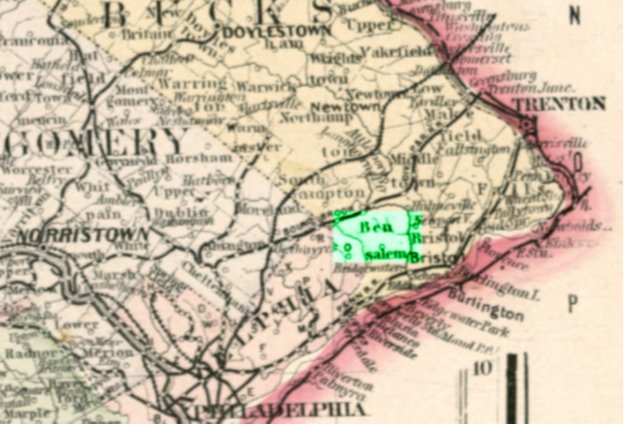
Portion of a map of Pennsylvania, showing location of Bensalem, Bucks County
As can be seen in the provided map, Bensalem lies about midway between Philadelphia, to the south, and Trenton, New Jersey, to the north.
In the spring of 1706 (presumably), only seven years after moving to Pennsylvania, Gerrit Stoffelse Vansand, age 62, died intestate (without a will). On June 20 of that year, five of the "sons of Garret Vansand, late of the said county, deceased" - i.e., Stoffel, Cornelius, Harman, Albert, and Johannes - along with their younger sister Jesina Vansand and younger brother, Garret Vansand, sold the property he had purchased in 1699, to their brothers Jacobus and George Vansand, for the sum of 150 Pounds "current money," excepting to Joseph Growden "convenient roads from Trevose to ye ford commonly called Carter's Ford and to his other lands lying below ye land hereby granted."
Following his death, Gerrit Stoffelse Vansand was reportedly laid to rest in the Old Reformed Churchyard at Feasterville, Bucks County, Pennsylvania, a burying ground full of ancient tombstones, which can still be seen behind a long stone wall in a residential area at Fairview Avenue and Pennsylvania Highway 132 (also known as Street Road).
Here is a Google Maps link to the location of the cemetery.
Jacobus Vansandt
(1685-1745)
Here is a brief biography from: William W. H. Davis, History of Bucks County, Pennsylvania (New York & Chicago: The Lewis Publishing Company, 1905), pp.24.
"JACOBUS (or James) VAN SANDT, son of Garret (1), was baptized at Flatbush, Long Island, February 15, 1685, and removed with his father to Bensalem, Bucks county, in 1699. He married at the First Presbyterian church of Philadelphia, on January 7, 1707-8, Rebecca Vandegrift, daughter of Nicholas and Barentje (Verkerk) Vandegrift, who had come to Bensalem from Long Island at the same date as the Vansants, (See Vandegrift Family). Jacobus and his wife joined the Bensalem church, Neshaminy branch, at its institution in 1710. On April 7, 1711, Benjamin Hopper conveyed to Jacobus Vansand, of Bensalem, yeoman, 100 acres of land in Southampton, and on January 1, 1712, his brother Harman Vansandt and Elizabeth his wife conveyed to Jacobus fifty acres adjoining the 150 which had been purchased by Harman of Ezra Bowen, June 13, 1711. He later purchased 144 acres of land of Cornelius Egmont, which he devised to his son Nicholas."
"The will of Jacobus Vansandt of Southampton, is dated December 12, 1744. And was proven January 9, 1745. It devises to son Jacob the 150-acre farm on which he dwelt, reserving certain privileges to his wife Rebecca; the Egmont farm to son Nicholas; mentions daughters Elizabeth and Rebecca as having received their shares, the latter being deceased: sons Jacobus, Garret and Isaiah, and grandson Charles Inyard, to have equal shares. The will names "kinsman John Vansand" and friend Nathaniel Brittian as executors, but they renouncing, as also did the widow, letters were granted to the sons James and Nicholas. The will is signed "J. V." His widow Rebecca survived him two years, leaving will dated November 18, 1746, and proved January 13. 1746-7, and mentions the same children, and grandson Charles Inyard. The children of Jacobus and Rebecca Vandegrift Vansandt were: Jacobus (or James) baptized December 1, 1708; married 10 mo, 1, 1732, Margaret Breece, daughter of Hendrick and Hannah (Field) Breece of Bensalem; see ancestry of Lewis R. Bond, in this volume. 2. Elizabeth, baptized May 21, 1710; married 4 mo. 1, 1732, Charles Inyard, of Warminster, and left one son, Charles Inyard. 3. Garret, married May 13, 1739, Ann Groome of Southampton. 4. Nicholas, baptized January 1, 1711-12, married May 18, 1744, Mary Brittian. 5. Rebecca baptized August 7, 1716, married Isaac Larue. 6. Isaiah, married June 6, 1732, Charity (or Gertrude) Van Horn. 7. Jacob."
Here are the land transactions referenced above and on file (except one) in the deed records of Bucks County, Pennsylvania:
- June 20, 1706: With brother George, purchased 150 acres of his late father's land in Bensalem, from other brothers and sister. Later (1711) relinquished his title to the same. (See Bucks County, Pennsylvania Deed Book 3, pp.258-60 and Deed Book 5, pp.38-41, in which George Vansand sold the land to Thomas Stevenson.)
- April 17, 1711: Purchased 100 acres in Southampton from Benjamin Hopper for 75 Pounds "lawful silver money of Pennsylvania." (See Bucks County, Pennsylvania Deed Book 4, pp.150-2.)
- January 1, 1712: Purchased 50 acres in Southampton from brother, Harman Vansand of Bensalem, yeoman, for 50 Pounds "lawful silver money of America." (See Bucks County, Pennsylvania Deed Book 4, pp.237-8.)
- July 1, 1738: Together with Henry Brees, Derrick Hogland, and John Crusen or Kroesen, yeomen, purchased one-half acre of land in Southampton for 5 shillings (for a graveyard?). (See Bucks County, Pennsylvania Deed Book 6, pp.278-9.)
- Date not known: Purchased 144 acres of land from Cornelius Egmont. (Deed apparently not recorded; see Davis, History of Bucks County, p.24.)
Jacobus Vansand died in Southampton, Bucks County, Pennsylvania probably in late 1744 or January 1745. Here is a transcript of the Last Will and Testament of Jacobus Van Zandt (complete with misspelled words and lack of punctuation):
I Jacobus Vansand of Southampton in the County of Bucks and Province of Pennsylvania Yeoman being of sound Mind & Memory and considering the uncertainty of Life and that it is appointed for men to Die Do make and ordain this my last Will and Testament Touching the Disposal of my worldly Estate which I Give devise and dispose of in manner following Viz.
After all my Just Debts & funeral Expences are paid out of my personal Estate by my Executor herein after named I Give and Bequeath to my beloved Wife Rebecca during her natural Life the lower Room in my new House and Bed & furniture and all my Goods therin and Priviledge of putting her Provissinous in the Cellar under it and free Egress & Regress in and out of the Premises I also Give her one Cow of her own Choice of my Cows and her Choice of one Riding Horse or Mare Also I Give & Bequeath to my to my said Wife in liew and in full for her Dower and all other Demands out of my Estate both real & personal the yearly sum of fourteen Pounds to be paid her every Year during her natural Life by my son Jacob and he shall also find her firewood and Hay & Straw for her Horse & Cow during her natural Life
Item I Give and Bequeath to my Son Nicholas and to his Heirs & Assigns for Ever all that Tract of Land and Plantation with all and singular the Appurtenances there unto belonging lying in Southampton he now dwelleth on which I bought of Cornelius Egmont containing one hundred & forty four acre or thereabout he paying the Loan Office what the same is Mortgaged for
Item I Give and Bequeath to my son Jacob and to his Heirs and Assigns for Ever All my Tract of Land and Plantation Lying in Southampton whereon I now Dwell containing one hundred & fifty aces Excepting & reserving out of the Same The Priviledges granted herein before mentioned to my Wife. And also that he the said Jacob shall pay to my Executor the Sum of three hundred and fifty pounds at thirty Pounds a year every Year till the whole be paid.
And whereas my sons Nicholas and Jacobus hath already had each the sum of ninty Pounds allowe them in the Value of the Plantations hereby given them. And I have also Given to my Son Garret my Daughter Rebecca and my Daughter Elizabeth deceased Each the sum of twenty Pounds in Part of their Portions and to my son Son (no mistake, word "son" is repeated) Jacobus the sum of ninty pounds
Item I do Will and Order that after my Debts & funeral Charges is paid the Residue of my personal Estate that shall arise out of my Goods & Chattells shall be divided among my Sons Garret & Isaiah and my Daughter Rebecca
Note here is a long Razure in the original will L. Groaden Dep Reg
____________________ in equal shares
And I do Will and appoint my Son Jacob retain & Keep in his Hands the above mentioned three hundred & fifty Pounds and not to pay any Part thereof untill his Mothers Death and afterwards shall pay it in ___ manner as above is directed.
Item I Give my Grandson Charles Inyard an Equal shsare of my Estate with my Children to be paid him when he arrives at the age of twenty one Years deducting out of his Share twenty Pounds which his Mother had in her Life time
Item in case there should not be enough with my Personal Estate and the Sum I have ordered Jacob to pay out of my Plantation to make each Childs Part and the sd Charles Inyard equal alike then in such case I Do Will & order my sons Nicholas & Jacobus to refund and pay back to my Executors equally so much as shall make each & Every [one] of my Childrens shares of my whole Estate equal except Jacob to whom I Give a further Legacy of forty Pounds and Do order my Executors to Deduct out of Isaiahs share twenty-five Pounds and out of Garrets share fifteen Pounds and pay the same to Jacob
And I Do hereby nominate constitute and appoint my Kinsman John Vansand and my friend Nathaniel Brittam Executors of this my last Will and Testament hereby ratifying and confirming this and no other to be my last Will & Testament
In Witness whereof I have hereunto set my Hand and Seal this twelfth Day of December in the Year of our Lord one thousand seven hundred & forty four
Jacobus Vansand
his VS mark
Signed Sealed Published and
Declared by the sd. Jacobus Vansand
to be his last Will and Testament
in the Presence of us
Daniel Bankson Thomas Duff Robert Vernon
Bucks [Co.?] The ninth Day of January 1745 Then appeared Daniel Bankson of Bristol in the sd County Boatman and Thomas Duff of the Citty of Philadelphia Baker two of the Witnesses to the within written Will and being legally Sworn did upon their oaths Respectively Depose and Declare that they were present & saw the within Testator Jacobus Vansand Sign Seal Publish and Declare the within Writing to be his last Will & Testament and that at the Doing thereof He was [of] Sound Mind Memory & Understanding to the best of their Knowledge
Sworn before Me Lawr Growdon
Bucks [Co.] Be it Remembered that on the Ninth Day of January Anno Domini one thousand seven hundred and forty five the last Will & Testament of Jacobus Vansand late of the County afores Yeoman Deceased was duly Proved according to Law. And John Vansand and Nathaniel Brittam who in the same Will are appointed Executors having renounced the Executorship thereof and utterly refused to Act therein and Rebecca Vansand Widdow & Relict of the sd. Testator haveing also Renounced the Administration of the sd. Testators Estate and defired that it may be granted to Jacobus Vansand & Nicholas Vansand two of the sons of the deceased
Therefore Administration of all & singular of the Goods & Chattells Rights & Credits of the sd. Testator with Coppy of the Will annexed is granted unto Jacobus Vansand of Warminster in the sd. Country Yeoman and Nicholas Vansand in the same county Yeoman They being first Solemnly Sworn & given Bond Well and truly to administer the Goods & Chattels Rights & Credits of the sd. Deceased and to Exhibit a true & perfect Inventory thereof into the Registers Office in one Month after Date hereof and a true and Just account thereof when thereunto required
Witness my Hand and Seal of the Office aforesd. The Eighteenth Day of January one thousand and seven hundred & forty five
Lawr. Growdon Dep. Regr.
Jacob Vansand was reportedly laid to rest in the Old Reformed Churchyard at Feasterville, Bucks County, Pennsylvania, a burying ground full of ancient tombstones, which can still be seen behind a long stone wall in a residential area at Fairview Avenue and Pennsylvania Highway 132 (also known as Street Road).
MAP OF THE LOWER END OF BUCKS COUNTY
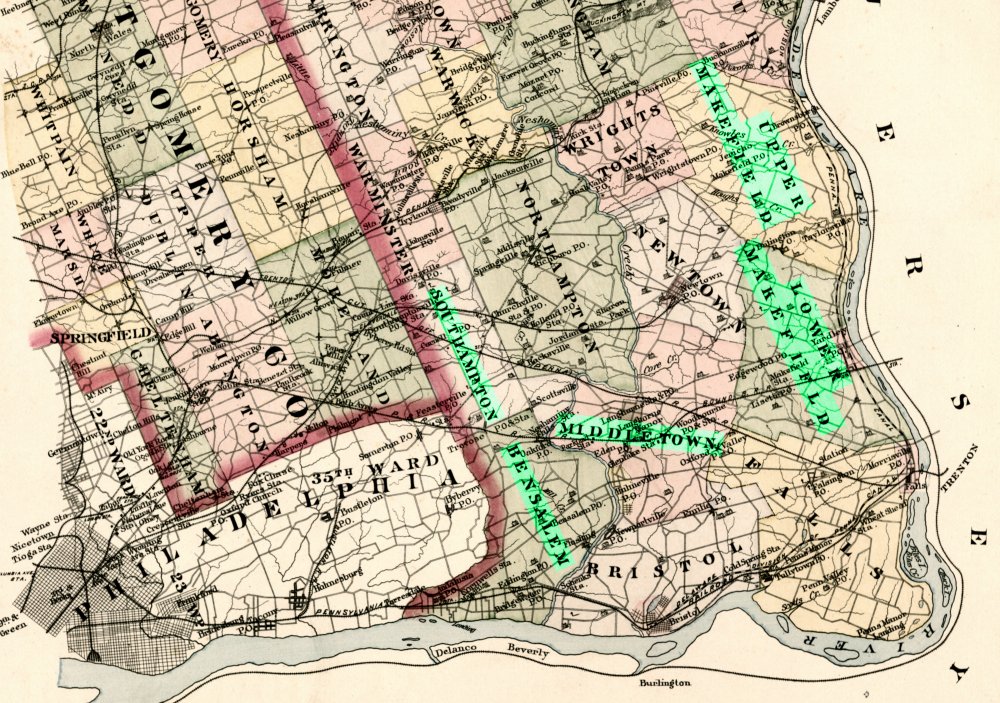
This 1891 map of Bucks County, PA shows its proximity to Philadelphia, with towns in which our Van Zandt ancestors owned property highlighted. Courtesy Library of Congress.
Isaiah Vansand, Sr.
(1713-1786)
Here's a brief biography from: William W. H. Davis, History of Bucks County, Pennsylvania (New York & Chicago: The Lewis Publishing Company, 1905), pp.24.
"Isaiah, the fourth son, married Gertje (or Charity) Van Horn, daughter of Peter and Elizabeth Van Horn of Middletown. On March 18, 1736-7, he purchased at sheriff's sale 178 1/4 acres of land in Makefield township. In 1754 he purchased a small tract adjoining, and in 1768 purchased of John Scott 100 acres in Upper Makefield. His children were: Isaiah; Elizabeth, wife of Cornelius Vandegrift: Rachel, wife of George Merrick, married 4 mo. 12, 1769; Charity; Sarah, who married Christian Van Horn, June 14. 1764: Mary, who married Gabriel Van Horn, January 18, 1772; Joshua: Peter, who married Elizabeth Wollard April 8. 1778, and (second) Alethia Curtis: Gabriel; and Cornelius, who married Mary Larzelere. The will of Isaiah Vansant is dated April 15. 1786, and proved September 28, 1786. It devises to son Joshua the bought of John Scott in Upper Makefield, and to Gabriel and Cornelius the home plantation, "reserving one -fourth of an acre for a graveyard, where I have begun to bury, for myself and my relations;" mentions Elijah, eldest son of Isaiah, daughter Rachel's three children; daughter Charity's four children, and daughter Mary, and her daughter Charity; and daughter Elizabeth."
Here are all the known land transactions for Isaiah Van Zandt, on file in the deed records of Bucks County, Pennsylvania:
- March 18, 1736: Purchased a "messuage tenement" and 178 ¼ acres of land "with all the houses, edifices, barns, buildings, orchards, gardens, ways waters, water courses, woods, meadows, marshes, swamps, cripples, fishings, fowlings, hawkings, huntings, rights, liberties, privileges, advantages, hereditaments and appurtenances whatsoever…according to the form and effect of the laws of this province in such cases made and provided under the Yearly quit rent due or to become due to the Chief Lords of the fee thereof," from the Sheriff of Bucks County for 213 Pounds "lawful money." A further notation says he paid 206 Pounds on June 6, 1737. (See Bucks County, Pennsylvania Deed Book 8, pp.230-2.)
- December 13, 1754: Purchased 3 acres and 3 perches of land in Middletown from John Cawley and wife, Margaret, for 12 Pounds "lawful money of Pennsylvania." (See Bucks County, Pennsylvania Deed Book 10, p.67-9.)
- April 30, 1768: Purchased 100 acres of land in Upper Makefield from John Scott and wife, Jane, for 500 Pounds of the "current money of the province." (See Bucks County, Pennsylvania Deed Book 33, pp.68-71.)
In his will, Isaiah Van Zandt, Sr. makes reference to all the above-identified parcels of land and also a tract that he purchased from Patrick Gregg, but there is no listing of it in either the Direct or Reverse Deed Indexes for the county.
Isaiah Van Zandt, Sr. died in Lower Makefield (presumably) in September 1786 (or possibly a month or so earlier), leaving a will.
Here is a transcript of the Last Will and Testament of Isaiah Van Zandt, Sr.:
I Isaiah Vansant of Lower Makefield and County of Bucks and State of Pennsylvania being weak of Body but of Perfect Mind and Memory thanks be to Almighty God therefore. And Calling to Mind the Mortality of this my Body and the Uncertainty of this Life Do make this my last Will and Testament in manner and form following
Imprimis I order that my Body be decently Buryed at the Discretion of my Executor hereafter named and that my Funeral Expences and all my just Debts be justly Paid and Discharged.
Item I do give unto my Son Isaiah Vansant the Sum of Fifty Pounds Current Money of Pennsylvania to be Paid to him in one Year after my Decease or at any Time after when he comes to Receive it but in Case he shall not be Living I give the same to his Eldest Son Elijah Vansant
Item I do Give unto my Daughter Elizabeth Rachels three Children Fifty Pounds Current Money to be equally Divided among them To be Paid three Years after my Decease.
Item I do give unto my Daughter Charity's four Children Fifty Pounds Current Money to be equally Divided among them and to be Paid them Four Years after my Decease.
Item I do Give unto my Daughter Sarahs two Children Fifty Pounds Current Money to be equally Divided between them to be Paid in four Years after my Decease.
Item I do Give unto my Daughter Mary the Sum of Fifty Pounds Current Money to be Paid within four Years after my Decease But in Case she be not living I Give the same to her Daughter Charity
Item I do Give unto my son Joshua Vansant all that Tract or Parcel of Land which I bought of John Scott situate in Uppermakefield To him his Heirs and Assigns forever he the sd Joshua Paying out of sd Land to Charity my wife his Mother three Pound a Year During her Life.
Item [I] do Give unto my Son Peter Vansant Two Hundred Pounds Current Money to be Paid to him in one Year after my Decease.
Item I do Give unto Gabriel Vansant my Son all the Southeasterly End of my Land or Plantation whereon I now live from Palmers Line up to a Black Oak Tree standing in John Brown's Line the Tree has been Left [or Lost?] and Stands in the Lower End of the Lane at the Heard of the Hollow of the little Field from thence Square from Browns Line across my Plantation to Subersers Line and also a Lott or Parcel of Land which I Bought of John Cowley called Woods Meadow. All which I Give unto him during my natural Life He the said Gabriel my Son Paying out of the Aforesaid Lands Fifty Pounds Current Money to my Executors hereafter named, to help them Pay the Debts and Legatees And also Pay six Pounds a Year to Charity my Wife his Mother as long as she shall live The Above Gabriel my Son making no wast nor Sail of anything thereunto belonging And after his Decease I Give the above sd Lands unto his Lawfull begotten Children their Heirs and Assigns forever his Son or Sons to have twice as much as his Daughters
Item I do give unto Cornelius Vansant my Son all the Northwesterly End of my Land and Plantation whereon I now live from Winder's Line down to a Black Oak Tree standing in John Browns Line at the head of the Hollow of the little Field it has some lims lost of and
[inserted between above and below] Line from thence Square from Browns Line across
is above One Hundred and Fifty four Rods from Winders Plantation to Subersers Line All which I Give unto him his Heirs and Assigns for ever except one Quarter of an Acre which I reserve for a Burying Ground where I have began to Bury for myself and Relations He the Said Cornelius my Son with the help of that Fifty Pounds from Gabriel my Son with the Money Money [no mistake, Money is repeated] Bonds Notes and Certificates to Pay of all my just Debts and Legatees And also to Charity my Wife his Mother six Pounds a Year as lone as she shall live I do Give unto Cornelius my Son all my Land in the Great Swamp which remains unsold of that I Bought of Patrick Gregg to him his Heirs and Assigns for ever
Item I do give unto my beloved wife Charity my Lodging Room with the Pravalege of going too and from the same which she please with good fire wood cut at a Proper length Brought to her Door with all my Puter my two best Beds and furniture suitable for Winter and Summer Potracking Pot and Tea Kettle Shovel and Tongs Handirons and Warming Pan the Round Table four Chears her choice the Looking Glass the use of the Corner Cubboard and my Walnut Desk the above mentioned Goods I do Give unto Charity my Wife for her use and Benefit during her life & after her Deceace the Desk and Cubboard to my son Cornelius the Rest I do Give to my Daughter Elizabeth and Granddaughter Rachel Merrick to be Divided equally between them
Item I do also Give unto my son Gabriel a Cow a Pott a Sow Case o Drawers - which I lent to him And all the Remainder of my Goods not mentioned above I do Give to my Son Cornelius And Lastly I do Constitute and appoint my two Sons Joshua Vansant and Cornelius Vansant my Executors of this my last Will and Testament - Thereby Revoking and Disallowing all other and former Wills by me made Ratifying and Confirming this only to be my last Will and Testament according to the true meaning thereof
In Witness whereof I have hereunto set my Hand and Seal this fifteenth Day of April in the Year of our Lord One Thousand Seven Hundred and Eighty six 1786
Isaiah Vanzant (seal)
Signed Sealed and Declared by the said Isaiah Vansant to be his last Will and Testament in the Presents of us Thomas Sharling, Nathan Brown, John Brown, Jnr.
Bucks [Co.?] The 28th Day of September Anno Domi: 1786 appeared Thomas Sharling, Nathan Brown and John Brown Jnr. the witnesses to the within Instrument of Writing who on their respective Affirmations Do Severally Declare and Say that they were Personally Present and Saw and heard Isaiah Vansant the the [no mistake, "the" repeated] Testator therein named, Sign, Seal, Publish and Declare the within and foregoing writing, as and for his last Will and Testament, and that at the time of his so doing he was of sound Mind Memory and Understanding to the best of their Knowledge & Belief.
Before me Joseph Hart Register
Bucks [Co.?]
Be it remembered that on the 28th day of September 1786 the last Will and Testament of Isaiah Vansant was duly Proved, when Letters Testamentary were Granted to Joshusa Vansant and Cornelius Vansant, Executors therein named, they being first duly Qualified well and truly to Administer the Goods and Chattles, Rights and Codicils of the Said Isaiah Vansant Deceased and that in one Month from this Date they will Exhibit unto the Registers Office for said County a just Inventory and Conscionable Appraisment of the Personal Estate of the Said Deceased and within one Year or when there unto lawfully Required, settle their Accounts of Administration.
Registered September 28th 1786 Joseph Hart Register
Although Isaiah mentioned setting aside a quarter acre of his land for a burying ground, where he was presumably buried after he died, its location has unfortunately been lost to history.
Isaiah Vanzant, Jr..
(1733-1791)
Isaiah Van Zandt, Jr., son of Isaiah Van Zandt, Sr. and his wife, Charity, was born 1733 in Bucks County, Pennsylvania. In 1754, at the age of 21, he married Maria Guyon. Together, they had the following named children:
- Elijah Van Zandt, born 1756
- Sarah Van Zandt, born 1762
- Rachel Creycia Van Zandt, born 1766
- John Van Zandt, Sr., born 1770
- Mary Van Zandt, d.o.b. unknown
As can be seen the will of Isaiah Van Zandt, Sr., Isaiah Van Zandt, Jr. did not inherit any land from his father, possibly because sometime before the Revolutionary War broke out, Isaiah Van Zandt and his family moved to one of the James River communities of Botetourt County, Virginia, a mountainous region in the western part of the state, where his wife, Maria, died sometime in 1782. Later that same year, on August 11, in Botetourt County, he married Margaret Thompson.
In 1780, at the height of the Revolutionary War in the Southern colonies, Isaiah Van Zandt, Jr. was drafted to serve in a Virginia regiment, but no doubt owing to his age at the time (47), he was able to send his son, Elisha, as a substitute for himself.
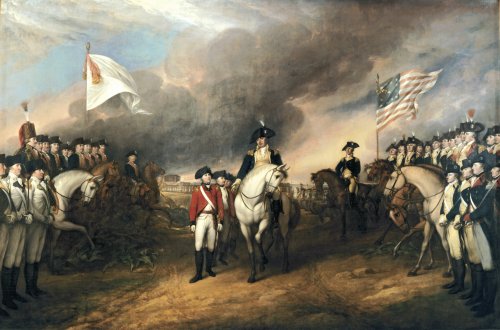 According to a statement by Elisha's widow, written in 1838, her husband served under General Nathaniel Green and was present at the Battle of Yorktown in 1781, the last major engagement of the war, and a British defeat (see picture, left). According to a statement by Elisha's widow, written in 1838, her husband served under General Nathaniel Green and was present at the Battle of Yorktown in 1781, the last major engagement of the war, and a British defeat (see picture, left).
In 1783, the same year that a treaty of peace was concluded between Great Britain and the United States, thus ending the Revolutionary War, Isaiah Van Zandt, Jr. was listed as a member of Captain James Smith's Botetourt County militia company. His son or brother, Elijah Van Zandt, was also listed. There seems to be no record of whether or not they saw any combat anywhere.
From the Library of Virginia website: "During its session begun in May 1780 the General Assembly passed an act authorizing the governor to impress supplies needed by the American army. The governor appointed commissioners of the provision law in each locality to carry out the terms of the act. The commissioner, when he impressed property, gave the owner a certificate describing what was taken. Between 1781 and 1783 county courts held special sessions at which certificates were presented and authenticated, and booklets listing authenticated certificates were compiled and sent to Richmond for settlement. Two commissioners appointed to settle the claims recorded those for which they authorized payment, and warrants were issued by the auditor of public accounts."
Isaiah Van Zandt's name is listed in the index of Public Claims.
Although Isaiah Van Zandt, Jr. and his family were living in Botetourt County during the 1780s, there are also two land transactions on record in neighboring Augusta County, as follows:
- August 18, 1784: Isaiah Van Zandt, Jr. and his wife, Margaret, sold 200 acres of land in Augusta County, which his wife had inherited from her father, Thomas Thompson, to Zachariah Johnston, for 60 Pounds. (See Augusta County, Virginia Deed Book 24, pp.352-4.)
- August 18, 1784: Isaiah Van Zandt, Jr. and his wife, Margaret, sold 230 acres of land in Augusta County, "lying and being in Beverly Manor," which his wife had inherited from her father, Thomas Thompson, to Zachariah Johnston, for 65 Pounds "current money of Virginia." (See Augusta County, Virginia Deed Book 24, pp.354-6.)
Botetourt County, Virginia deed records list the following transactions for Isaiah Van Zandt and his wife, Margaret:
- September 20, 1784: Isaiah Van Zandt purchased 80 acres of land "on [the] south side of [the] James River," for 80 Pounds "current money of Virginia," from Walter Lindsey and Mary, his wife. (See Botetourt County, Virginia Deed Book 3, pp.301-2.)
- September 29, 1784: Isaiah Van Zandt purchased 32 acres of land "on [the] south side of [the] James River," for 40 Pounds "current money of Virginia," from Walter Lindsey and Mary, his wife. (See Botetourt County, Virginia Deed Book 3, pp.300-1.)
- October 9, 1784: Isaiah Van Zandt purchased 110 acres of land "on [the] North side of Catawba Creek, a branch of [the] James River," for 30 Pounds "current money of Virginia," from James Aston and Jane, his wife. (See Botetourt County, Virginia Deed Book 3, pp.304-5.)
- September 13, 1787: Isaiah Van Zandt and his wife, Margaret, sold, for 225 Pounds "current money of Virginia," four tracts of land "lying and being situate in the forks of [the] James River and Catawba Creek…a branch of [the] James River" one tract containing 116 acres "including his grist mill," a second tract containing 110 acres "on the North side of Catawba Creek," another containing 80 acres "on [the] south side of [the] James River," and a fourth tract containing 32 acres "on [the] south side of [the] James River," to James M. Carrell, Sr. (See Botetourt County, Virginia Deed Book 3, pp.508-10.)
In addition to these deeds, Kegley's Virginia Frontier mentions a survey that was done on September 1, 1782, of Isaiah Van Zandt's "116 acres on Catawba, including his grist mill." Thus, we know that he was a miller by trade.
The September 13, 1787 land transaction (above) makes it clear that the Isaiah Van Zandt family did not stay very long in Botetourt County, Virginia; about five years altogether. After selling their land in Virginia, they moved south along the mountains, some 200 miles or more, to Greene County, Tennessee (then North Carolina).
On November 17, 1790, Governor William Martin of North Carolina granted Isaiah Van Zandt, Jr. 356 acres in Greene County, adjacent to John Wilson's land, in payment of 10 Pounds for every hundred acres. (See Greene County, Tennessee Deed Book 3, pp.362-3. Also North Carolina Land Patent Book 76, p.126.)
Isaiah Van Zandt, Jr. reportedly died in Greene County, North Carolina/Tennessee in 1791. Unfortunately, a search of Greene County court minutes from the February 1791 term to the February 1792 term, inclusive, shows no record of any kind regarding the death and/or estate of Isaiah Van Zandt.
However, a transcript of the will of Isaiah Van Zandt, Jr. can be found on two websites, neither of which say where the original document may be found. My search of probate records for both Greene County, North Carolina and Greene County, Tennessee have turned up nothing. There is no reason, however, to believe that the following transcript, taken from one of these websites, is not complete and accurate:
I, Isaiah Vansandt Of The County Of Green And State Of North Carolina Being At This Present Time In A State Of Health But Of Perfect Memory And Knowing That It's Appointed For All Men To Die I Take Opportunity To Settle My Worldly Affairs In The Following Manner That Is To Say:
Firstly, It's My Will And Desire That All My Just Debts Be Promptly Paid And Discharged.
Secondly, It's My Will And Desire That The Land I Bought Of John Prior Containing Three Hundred And Fifty Six Acres Be Divided As Follows: By A Line Beginning At The Spring Extending Through The Cleared Land Dividing It In Two Equal Parts From There Through Whole Land Dividing The Whole Into Two Equal Parts The One Half Of Which I Bequeath Unto My Son John Vansandt And His Heirs Forever And The Other Half Unto My Son George Vansand And His Heirs Forever.
Thirdly, The Tract Of Land I Bought Of John Wilson And John Lescollet Being In The Cove And Containing Hay The Same As Now Laid Off One Hundred And Thirty Six Acres With All It's Opportunities I Bequeath To My Son Thompson Vansandt And His Heirs Forever.
Fourthly, The Mill And The Land There Unto Belonging I Bequeath Unto Margaret Vansandt My Lawful Wife In The Following Manner. She Shall Enjoy Every Privilege There Belonging Without Paying Aney Annuity What Ever Until Such Times That My Daughter Mary Vansandt Either Marries Or Comes Of Age. She Shall Then Pay Her Forty Pounds And Then She Shall Enjoy The Same Privilege As Before Sutch Times As My Daughter Margaret Vansandt Comes Of Age Or Marries She Shall Then Pay Her Forty Pounds And Then She Shall Enjoy The Privilege Of The Land And Mill During Her Natural Life At The Expiration Of Whitch Time Said Mill And Land Shall Be Sold And The Price Arising There From Shall Be Equally Divided Between The First Five Legatees.
Fifthly, I Appoint And Ordain John Lescollet And John Wilson My True And Lawful Executors Of This My Last Will And Testament That They Act And Do In Every Respect According And Meaning Of This Will As There Is Several Things Now In Operation Not Fitting For A Women And Orphan Children To Manage Sutch As Covering Hovel And Rifles Guns Etc.
Its My Will And Desire That My Executors Should Trade Away For Those Things More Suitable Especially One Young Horse Or Mare Worth Ten Or Twelve Pounds To Be Given To My Son John Vansandt Over And Above His Share Of The Land. All Debts Due Or Here After Become Due To The Estate Within The Limits Of North Carolina Either By Bond Or Rent Or Open Account Or Any Other Way It's My Will And Desire My Executors See The Same Punctually Paid And Made Lawful Use Of For The Raising Of The Orphan Children And Schooling Them And The Support Of The Widow.
It's My Will And Desire That 250 Acres Of Land Containing The Iron Bank Belonging To Isaiah Vansandt And James Pearce Be Settled And My Part Sold.
Whereas I Have A Sum Of Money In Hard Cash Being In Bucks County In The State Of Penselvaney [sic] I Hearby Authorize And Appoint My Son Elijah Vansandt My Soule Executor To Act In That Department He Shall Receive The Same Money And After Paying Himself For His Trouble Shall Divide The Remainder Equally Between Himself Elijah Vansandt, Elisha Vansandt And Ezekiel Vansandt And Rachel Vansandt And Sarah Vansandt And Elizabeth Vansandt.
Lastly I Acknowledge This To Be My Last Will And Testament Given Under My Hand And Seal This Eighth Day Of August In The Year Of Our Lord One Thousand Seven Hundred And Eighty Nine.
(Signed) Isaiah Vansandt (His Seal)
Acknowledge Sealed And Signed In The Presents Of Us Test-----
John Lescollet
John Wilson
Samuel Hutchinson
Rouben Simpson
Joseph Lyles
William Wilson
W. Stroud
[Note: Please Note That The Connection Of The Two Isaiah's Is Completely Documented By Their Wills In That Isaiah Sr Bequeathed Fifty Pounds Cash To Isaiah Jr--If He Is Not Living, It Will Go To Elijah Vansandt, Eldest Son Of Isaiah Jr., In His Will, Isaiah Jr Appointed His Eldest Son, Elijah, Executor To Collect The Sum Of Fifth Pounds Cash Owed Him In Bucks Co. Pa].
Will transcript and note from: https://www.werelate.org/wiki/Person:Isaiah_Vansant_(1)
MAP OF VIRGINIA SHOWING LOCATION OF BOTETOURT COUNTY
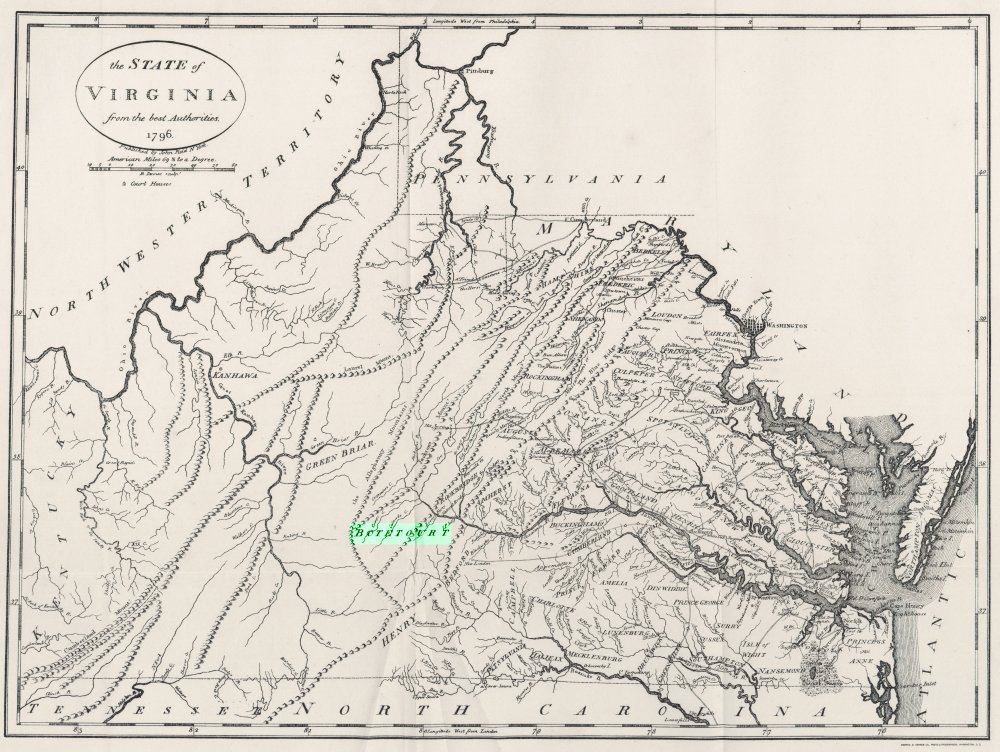
Courtesy Library of Congress.
John Vanzandt, Sr.
(1770-1832)
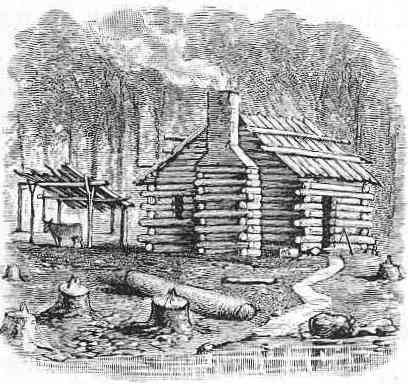 John Van Zandt, Sr., son of Isaiah Van Zandt, Jr. and his wife, Maria Guyon Van Zandt, was born in Bucks County, Pennsylvania about 1770. When he was a boy, his family moved to Botetourt County, Virginia, where they remained until the late 1780s, when they settled in Greene County, North Carolina, which in 1796 became Greene County, Tennessee. John Van Zandt, Sr., son of Isaiah Van Zandt, Jr. and his wife, Maria Guyon Van Zandt, was born in Bucks County, Pennsylvania about 1770. When he was a boy, his family moved to Botetourt County, Virginia, where they remained until the late 1780s, when they settled in Greene County, North Carolina, which in 1796 became Greene County, Tennessee.
When John Van Zandt's father, Isaiah Jr., died in 1791, John inherited 178 acres of his father's land in Greene County. His brother, George, also inherited 178 acres, the total being 356 acres that their father had purchased from a man named John Prior.
On April 18, 1797, John Van Zandt, Sr. married Nancy Wilson, daughter of Ephraim Wilson, in Greene County, Tennessee. Together, they had the following named children:
- John Van Zandt, Jr. date of birth unknown
- Isaiah Van Zandt, born about 1805
- Sarah Van Zandt, born about 1806
- Elisha Van Zandt, born about 1808
- Joshua Van Zandt, born about 1815
- Hiram Van Zandt, date of birth unknown
- Deliliah Van Zandt, date of birth unknown
|
And a few more children, male and female, whose names have been lost to history.
Here are land transactions for John Van Zandt on file in the Greene County Courthouse at Greeneville, Tennessee:
- November 12, 1795: As executor of his father's estate, along with co-executor John Sascoleet, John Van Zandt, Sr. sold 258 acres of land in Greene County "on the east fork of Cove Creek[,] waters of [the] Nolichucky [River]" for 25 Pounds "Virginia currency," to James Pierce (or Pearce). See Greene County, Tennessee Deed Book 6, pp.100-2.
- February 11, 1797: John Van Zandt, Sr. (shown as John Vinzant), as "heir at law of Isaiah Vinzant," sold 63 acres "lying on the south side of [the] Nolichucky River on a branch of Cove Creek," to Thomas Wilkinson for $20. See Greene County, Tennessee Deed Book 6, pp.253-4.
- December 11, 1797: This transaction did not directly involve John Van Zandt. As co-executors of the estate of Isaiah Van Zandt (shown as Isaiah Vinzant), John Suscolleet (or Sascolleet) and John Wilson sold 156 acres of land in Greene County previously belonging to Isaiah Van Zandt, deceased, to Ephraim Wilson, for $50. See Greene County, Tennessee Deed Book 6, pp.260-1.
- October 26, 1812: John Sascolleet, executor of the estate of Isaiah Vansandt, deceased, and John Vandsandt of Giles County, Tennessee, heir of Isaiah Vansandt, sold 178 acres of land in Greene County within the "bounds and courses of a plantation granted to Isaiah Vansandt Deceased for 356 acres Number 865…on the south side of [the] Nolachuckey [sic] River and branch of Cedar Creek" to James Jack for $300.
In light of the last listed land transaction above, it seems that John Van Zandt and family removed to Giles County, Tennessee sometime between 1797 and 1812, although no land transactions for him of any kind or date can be found in Giles Country records, nor is he listed on the extant 1812 tax list for Giles County.
The earliest U.S. Census record we can find for John Van Zandt, Sr. is the 1820 Census for Jackson County, Tennessee, which shows:
Enumeration Date 7 Aug 1820
Home in 1820 (City, County, State) Jackson, Tennessee, USA
Free White Persons - Males - Under 10 2
Free White Persons - Males - 10 thru 15 1
Free White Persons - Males - 16 thru 25 3
Free White Persons - Males - 45 and over 1
Free White Persons - Females - Under 10 1
Free White Persons - Females - 10 thru 15 2
Free White Persons - Females - 26 thru 44 1
Number of Persons - Engaged in Agriculture 7
Number of Persons - Engaged in Manufactures 1
Free White Persons - Under 16 6
Free White Persons - Over 25 2
Total Free White Persons 11
Total All Persons - White, Slaves, Colored, Other11
This record is consistent with what we know about the family. The two males under age ten would be Elisha and Joshua; the one male 10 through 15 is Isaiah, most likely; and one of the three males 16 through 25 is likely John Van Zandt, Jr. The names of the other two are unknown. The female 26 to 44 is John's wife, Nancy. The name of the one female under ten is unknown. The name of one of the two females 10 through 15 would be Sarah (my direct ancestor). The name of the other female is unknown.
Unfortunately, due to a courthouse fire, none of the early nineteenth century records of Jackson County, Tennessee are available, so we have no way of knowing the extent of John Sr.'s land holdings in that county. We do know, however, that his son, John Jr. received five grants of land in Jackson County, from the State of Tennessee, between 1826 and 1830.
MAP OF TENNESSEE SHOWING LOCATION OF GREENE, JACKSON and McMINN COUNTIES
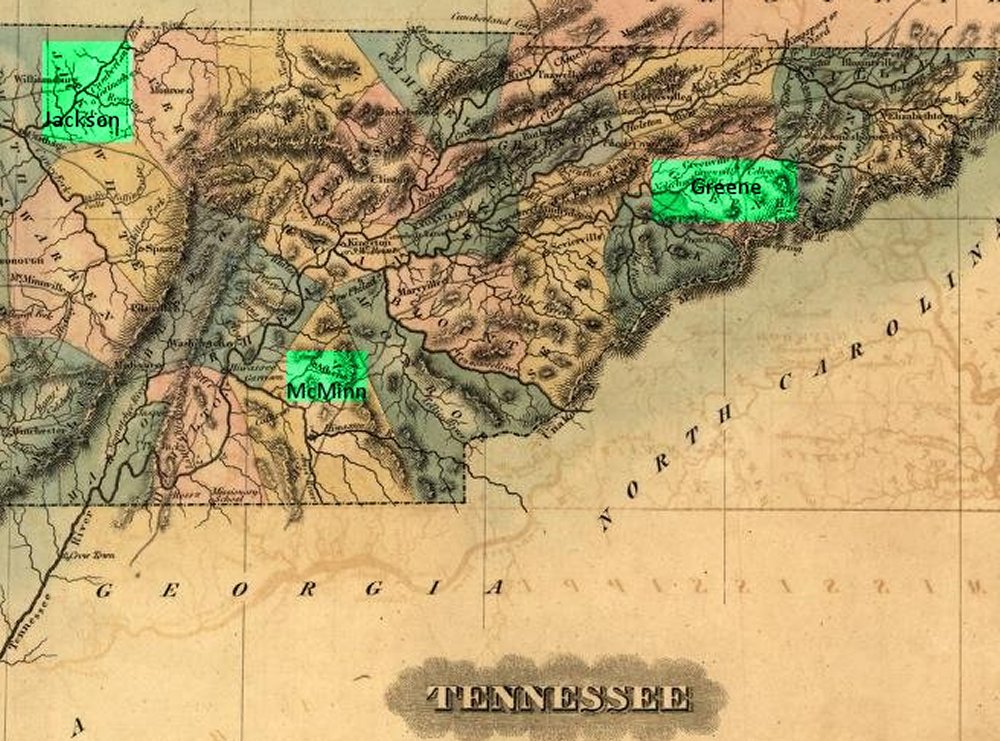
Courtesy Library of Congress.
By 1830, John Van Zandt, Sr. and family had moved to McMinn County, Tennessee, where they were enumerated in the 1830 federal census as follows:
Name John Vinzant
Home in 1830 (City, County, State) McMinn, Tennessee
Free White Persons - Males - 10 thru 14 1
Free White Persons - Males - 15 thru 19 1
Free White Persons - Males - 20 thru 29 1
Free White Persons - Males - 40 thru 49 1
Free White Persons - Females - 15 thru 19 1
Free White Persons - Females - 40 thru 49 1
Free White Persons - Under 20 3
Free White Persons - 20 thru 49 3
Total Free White Persons 6
Total - All Persons (Free White, Slaves, Free Colored) 6
There are only two land transactions on record in McMinn County, Tennessee, involving John Van Zandt, Sr. One is found in McMinn County Deed Book B, pp.473-4, dated December 28, 1832, in which he sold 80 acres of land in McMinn County for $800 to Thomas Atchley. The land was described as being "the west half of the northeast quarter of the first section of the fourth fractional township Range second west of the Meridian Hiwassee district." Unfortunately, there seems to be no record of how John Sr. acquired this land in the first place.
The other record, dated September 4, 1833, is found in McMinn County Deed Book C, pp.106-7, in which John Sr. bought 114 acres of land in McMinn County from James G. Harris, for which he paid $500. The land was described as being "the southeast quarter in the Hiwassee District, second range west of the meridian fourth fractional township, fourteenth section."
It appears that John Van Zandt, Sr. died intestate (without a will) in McMinn County in 1834. The only estate or probate record that can be found is dated June 3, 1834. It is located in McMinn County Probate Book No. ?, po.145, showing that his widow, Nancy, and son, John, Jr., purchased various items of his estate, including livestock.
The burial place of John Van Zandt, Sr. has apparently been lost to history.
Sarah Vanzandt Coons
(b.abt. 1805)
Sarah Van Zandt, a daughter of John Van Zandt, Sr. and his wife, Nancy, was born about 1805, probably in Greene County, Tennessee. About 1824, she was married to Martin Coons, Jr. in Jackson County, Tennessee. Together, they had at least seven children, including my great-great-great grandmother, Delilah Coons. Sarah died sometime between 1870 and 1880, probably in Johnson County, Illinois.
Some Noteworthy Van Zandt Cousins
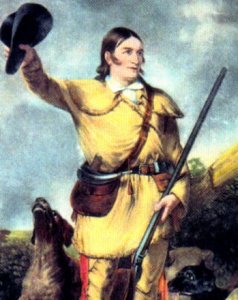 My seventh great-grandfather, Isaiah Van Zandt, Sr., had a brother named Garret, who had a son named Jacob Van Zandt, Sr. Sometime during the early nineteenth century, Jacob Van Zandt, Sr. and his family settled in Franklin County, Tennessee, where they apparently lived in the same general area (the southern part of the county) as the famous frontiersman David or "Davy" Crockett (see picture, left) and his family, so near in fact that just before Jacob Sr. died in 1815, he asked his neighbor, David Crockett, to sign his will as a witness to his own signature. Crockett's son, John Wesley Crockett, also signed. (See Franklin County, Tennessee Will Book 1808-1876, pp.27-8.) My seventh great-grandfather, Isaiah Van Zandt, Sr., had a brother named Garret, who had a son named Jacob Van Zandt, Sr. Sometime during the early nineteenth century, Jacob Van Zandt, Sr. and his family settled in Franklin County, Tennessee, where they apparently lived in the same general area (the southern part of the county) as the famous frontiersman David or "Davy" Crockett (see picture, left) and his family, so near in fact that just before Jacob Sr. died in 1815, he asked his neighbor, David Crockett, to sign his will as a witness to his own signature. Crockett's son, John Wesley Crockett, also signed. (See Franklin County, Tennessee Will Book 1808-1876, pp.27-8.)
Jacob Van Zandt, Sr. had a son named Jacob Van Zandt, Jr., who served in a company of volunteers raised in Franklin County, Tennessee for service in the Creek Indian War of 1813-1814. David Crockett also served in a volunteer company raised in Franklin County, though apparently a different one. In his 1834 autobiography, Crockett says that during the Creek Indian War, he went hunting with a "Mr. Van Zandt" to obtain fresh meat for the troops. (See A Narrative of the Life of David Crockett of Tennessee, pp.118-20.) For two reasons, I believe that the "Mr. Van Zandt" to which Crockett referred was probably Jacob Van Zandt, Jr. First, because it's obvious from his witnessing the will of Jacob Van Zandt, Sr. that David Crockett knew the Van Zandt family, secondly because in 1834, David Crockett, then living in Weakley County, Tennessee, sold Jacob Van Zandt, Jr. a 250-acre tract of land in Franklin County, which had previously belonged to Crockett's late father-in-law, James Patton. (See Franklin County, Tennessee Deed Book O, p.8-10.) This strongly suggests that the two men, who were exactly the same age (both born in 1786), were friends who'd stayed in touch over the years, even though Crockett had moved from Middle Tennessee to the western part of the state.
Deed of sale of land by David "Davy" Crockett to Jacob Van Zandt (Franklin County, TN Deed Book O, p.8)
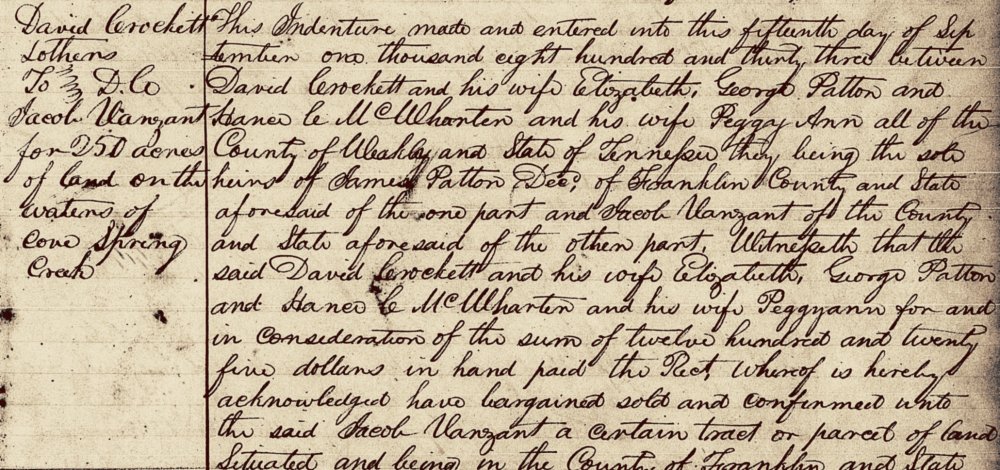
For the record: Jacob Van Zandt, Sr. was my first cousin 8x removed. His son, Jacob Jr. was my second cousin 7x removed.
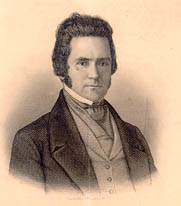 Jacob Van Zandt, Jr. had a son named Isaac (see picture, left) who in 1838 moved himself and his family to the Republic of Texas, settling in Harrison County, where he practiced law. In 1842, Texas President Sam Houston appointed him charge d'affaires to the United States, where he helped negotiate a treaty of annexation. He died in 1847 while campaigning for Governor of the State of Texas. Van Zandt County in East Texas is named for him. Isaac Van Zandt was my third cousin 6x removed. Jacob Van Zandt, Jr. had a son named Isaac (see picture, left) who in 1838 moved himself and his family to the Republic of Texas, settling in Harrison County, where he practiced law. In 1842, Texas President Sam Houston appointed him charge d'affaires to the United States, where he helped negotiate a treaty of annexation. He died in 1847 while campaigning for Governor of the State of Texas. Van Zandt County in East Texas is named for him. Isaac Van Zandt was my third cousin 6x removed.
One of Isaac Van Zandt's sons, Khleber Miller Van Zandt (born in Franklin County, Tennessee), was a prominent citizen of Fort Worth, Texas and my fourth cousin 5x removed. Famed folk singer Townes Van Zandt (1944-1997) was a descendant of Isaac Van Zandt and my seventh cousin 2x removed.
Van Zandt Family
Christoffel Harmenszen |
Gerrit Stoffeles Vansand |
Jacobus Vansand
Isaiah Vansand, Sr. |
Isaiah Vanzant, Jr. |
John Vanzandt |
Sarah Vanzandt Coons
Some Noteworthy Van Zandt Cousins
BIOGRAPHIES INDEX
This website copyright © 1996-2025 by Steven R. Butler, Ph.D. All rights reserved.
|















 According to a statement by Elisha's widow, written in 1838, her husband served under General Nathaniel Green and was present at the Battle of Yorktown in 1781, the last major engagement of the war, and a British defeat (see picture, left).
According to a statement by Elisha's widow, written in 1838, her husband served under General Nathaniel Green and was present at the Battle of Yorktown in 1781, the last major engagement of the war, and a British defeat (see picture, left).
 John Van Zandt, Sr., son of Isaiah Van Zandt, Jr. and his wife, Maria Guyon Van Zandt, was born in Bucks County, Pennsylvania about 1770. When he was a boy, his family moved to Botetourt County, Virginia, where they remained until the late 1780s, when they settled in Greene County, North Carolina, which in 1796 became Greene County, Tennessee.
John Van Zandt, Sr., son of Isaiah Van Zandt, Jr. and his wife, Maria Guyon Van Zandt, was born in Bucks County, Pennsylvania about 1770. When he was a boy, his family moved to Botetourt County, Virginia, where they remained until the late 1780s, when they settled in Greene County, North Carolina, which in 1796 became Greene County, Tennessee.
 My seventh great-grandfather, Isaiah Van Zandt, Sr., had a brother named Garret, who had a son named Jacob Van Zandt, Sr. Sometime during the early nineteenth century, Jacob Van Zandt, Sr. and his family settled in Franklin County, Tennessee, where they apparently lived in the same general area (the southern part of the county) as the famous frontiersman David or "Davy" Crockett (see picture, left) and his family, so near in fact that just before Jacob Sr. died in 1815, he asked his neighbor, David Crockett, to sign his will as a witness to his own signature. Crockett's son, John Wesley Crockett, also signed. (See Franklin County, Tennessee Will Book 1808-1876, pp.27-8.)
My seventh great-grandfather, Isaiah Van Zandt, Sr., had a brother named Garret, who had a son named Jacob Van Zandt, Sr. Sometime during the early nineteenth century, Jacob Van Zandt, Sr. and his family settled in Franklin County, Tennessee, where they apparently lived in the same general area (the southern part of the county) as the famous frontiersman David or "Davy" Crockett (see picture, left) and his family, so near in fact that just before Jacob Sr. died in 1815, he asked his neighbor, David Crockett, to sign his will as a witness to his own signature. Crockett's son, John Wesley Crockett, also signed. (See Franklin County, Tennessee Will Book 1808-1876, pp.27-8.)
 Jacob Van Zandt, Jr. had a son named Isaac (see picture, left) who in 1838 moved himself and his family to the Republic of Texas, settling in Harrison County, where he practiced law. In 1842, Texas President Sam Houston appointed him charge d'affaires to the United States, where he helped negotiate a treaty of annexation. He died in 1847 while campaigning for Governor of the State of Texas. Van Zandt County in East Texas is named for him.
Jacob Van Zandt, Jr. had a son named Isaac (see picture, left) who in 1838 moved himself and his family to the Republic of Texas, settling in Harrison County, where he practiced law. In 1842, Texas President Sam Houston appointed him charge d'affaires to the United States, where he helped negotiate a treaty of annexation. He died in 1847 while campaigning for Governor of the State of Texas. Van Zandt County in East Texas is named for him.